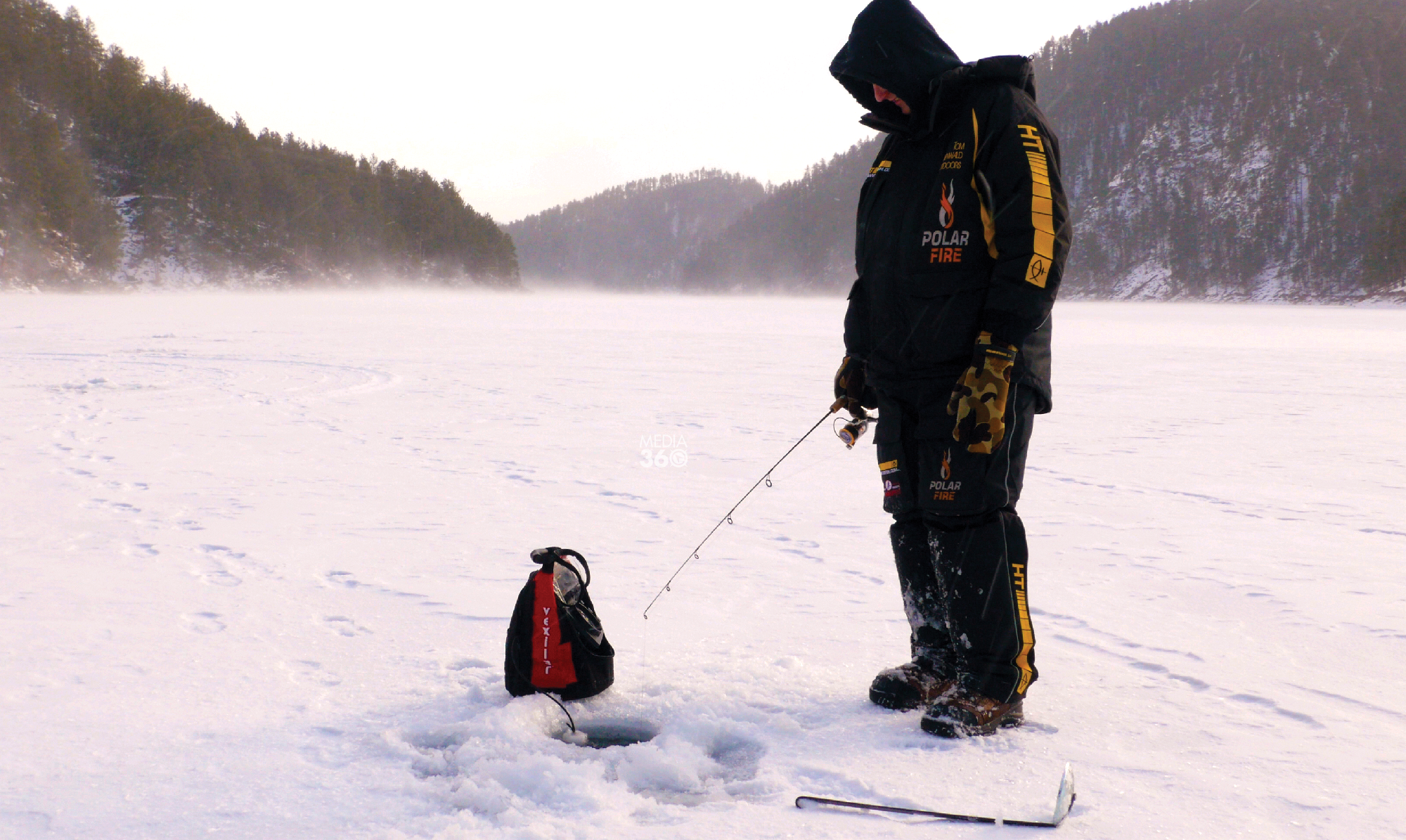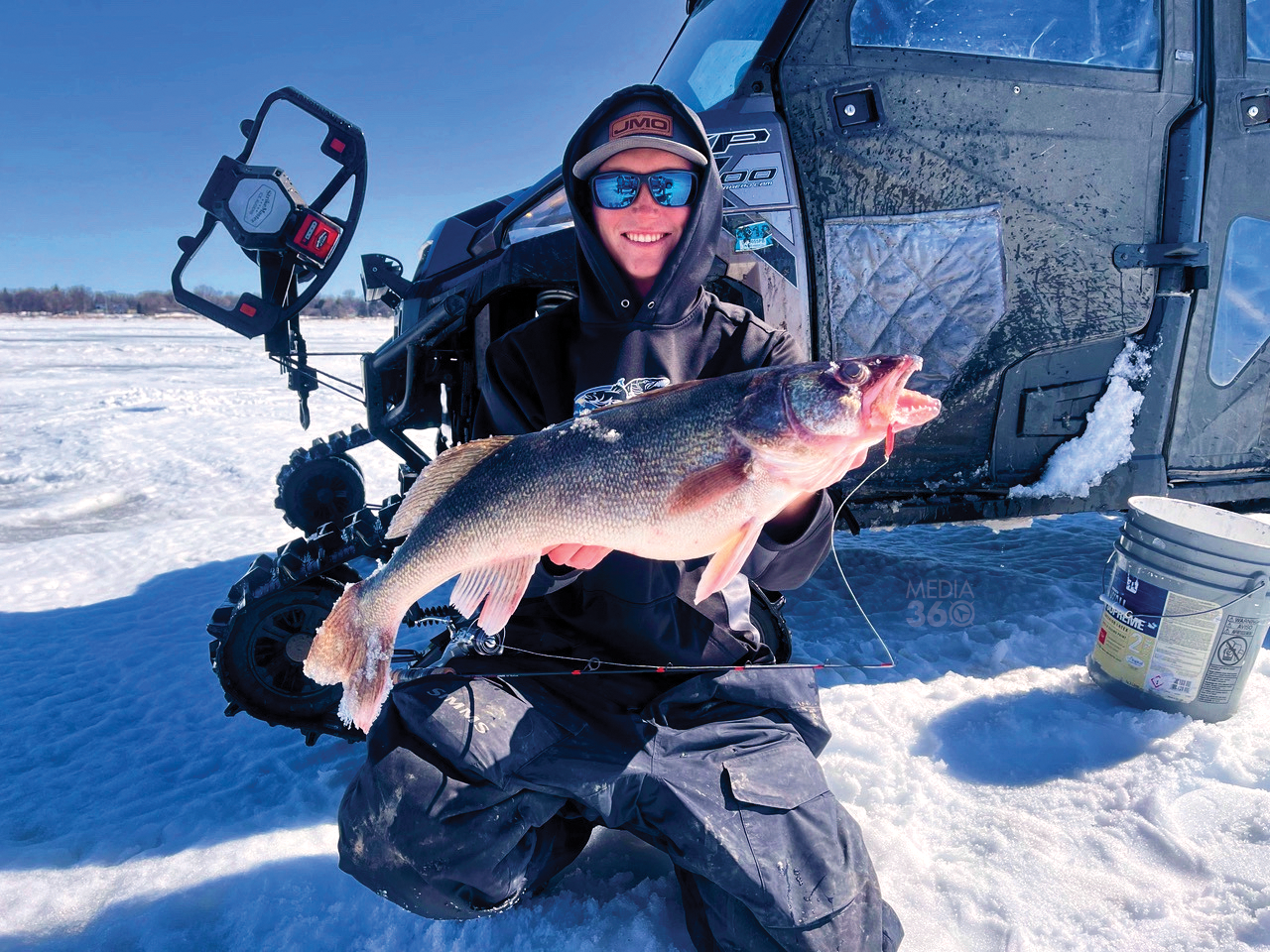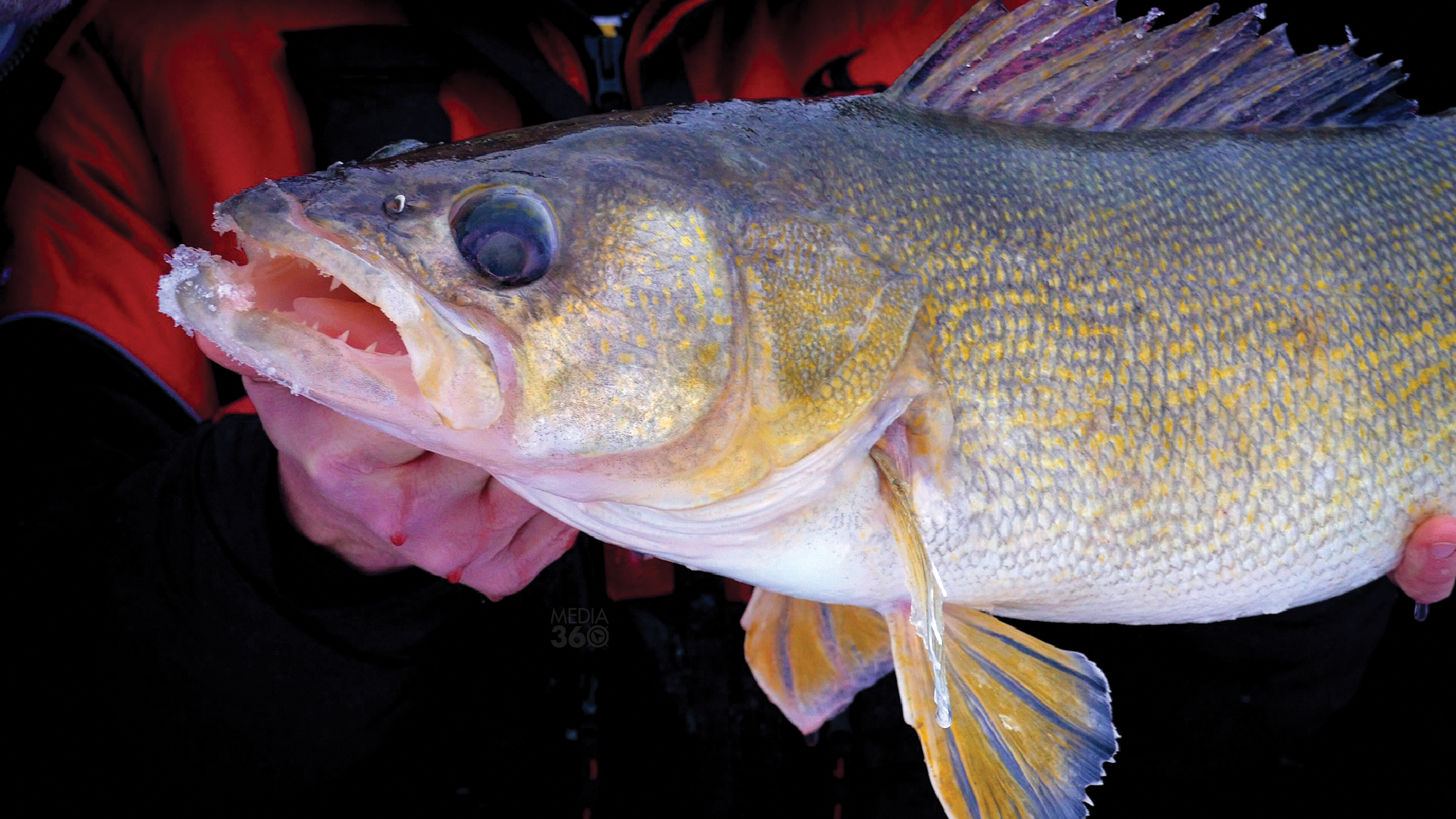Let’s stop for a moment, set everything aside and take a phantasmic journey into a hardcore ice angler’s dream world.
A wish. One perfect season beginning early and ending late, featuring consistently ideal weather coupled with an unlimited budget.
No bounds.
Given such exceptional opportunity, I’d target larger waters, visiting nearby small-scale jewels as desired, traveling between the best of the best, fishing every day, all day, all season long.
Flaming Gorge Reservoir, Wyoming/Utah
Moving west to east, I’d begin at the Gorge, where a strong population of lake trout is the intriguing draw.

“Catches average 20-22 inches,” said Wyoming fish biologist John Walrath. “With a limit of 12 per day on those measuring under 28” and one over 28” — it’s these giants, varying from 15-50 pounds or more, that attract many anglers.”
Try jigging them with luminescent, white or crayfish colored 1/4- to 1/2-ounce jigging spoons, Jigging Rapalas, blade baits, or brightly colored tubes tipped with thin, thumbnail-size slices of sucker, chub or Sculpin. Explore along main channel flats, humps, points and ridges ranging from 40-100 feet deep.
“Rainbow trout are present and found in bays and along shorelines,” Walrath added. “The recently introduced Bear River Cutthroat tend to suspend over deeper water. Catches of both range from about 14-20 inches.”
Burbot, an illegally introduced species that cannot be released alive, are best targeted at night with glow lures fished near bottom, 20-60 feet deep.
Pactola Reservoir, South Dakota
Moving east, Pactola offers exemplary opportunity.

“The flooded basin harbors an old mining town by the same name — footings can be seen on a graph — along with some big lakers,” said Craig Oyler of Black Hills Guide Service. “Fish average 26-30 inches, with 40 inches plus possible. I usually start along breaks in 35-40 feet, and if I don’t locate fish, go deeper along steep ledges where lake trout ambush rainbow smelt or chase schools of suspended bluegills. Work the entire column while intently watching your graph.
“The water is clear, so anything flashy draws fish. Bright flutter spoons resembling smelt are effective search baits, and 1/4- to 1/2-ounce jigs tipped with plastics, especially those simulating the lake’s Mysis shrimp, get hit hard.” Oyler’s favorite? A Cold Snap Maki Plastic “Craigi XL” — a giant, 4-inch meaty representation of a Mysis on steroids.
As a bonus, incidental catches of pike, brown or rainbow trout always remain in the cards.
Fort Peck, Montana
Any Missouri River impoundment delivers gripping prospects, and Peck comprises an ice angler’s fantasy, as this remote, massive reservoir reaches depths down to 200 feet, is rich with structure and supports a tempting multi-species fishery.
“A bucket list destination for anyone looking for numbers of 8- to 15-pound lake trout,” confirmed Mike Howe, premier Montana outfitter and guide. “Look for suspended fish looming around steep, 40- to 120-foot breaks, where giant schools of ciscoes provide their primary food source. Jigging lipless crankbaits or heavy, flashy flutter spoons works well, but nothing beats a 4- to 6-inch tube on a 3/4- to 1-ounce jig head.
“While numbers of walleye are available, quick limits aren’t why you come to Peck,” Mike said. “If your big fish tactics are on point, you’ll be rewarded. Walleye reach trophy potential quickly, with 26- to 32-inch fish reasonable expectations. Focus your efforts in 5-25 feet of water, but watch for suspended walleyes feeding on cisco, too.”

Northern pike are prolific, with fish in the 35- to 45-inch class common, providing action between trout and walleye.
“Just a word of warning,” Mike emphasized. “These waters are secluded and venturing out alone could prove fatal. Check in at Lakeridge Lodging and Bait Shop or Fort Peck Marina before setting out — and heed their advice.”
Devils Lake, North Dakota
This classic ice destination is swelling with yellow perch, walleye, pike, white bass and some big crappies, too.
“Devils Lake comprises thousands of acres of connecting waters. From the Alice-Irvin-Mikes chain south of Cando all the way to East Stump Lake, this incredible complex is as varied as any system in the lower 48,” said Mike Howe, who makes regular pilgrimages to this mecca. “Water levels had been down, but recent near-record precipitation has brought them back up, putting fish in places that had been dry for years.”
“Walleye numbers are near all-time highs,” added guide Ancil Reynolds. “Bite windows can be all over the map, but their sheer number means you can almost always find feeding ‘eyes. Last winter, we caught 90% of them in water less than 12 feet. Perch were somewhat deeper. Pike can be caught nearly all day and provide consistent action. White bass fishing is amid the best you’ll find anywhere — and crappies, while not overly abundant, can be huge!”

Flooded timber, fence lines, roadways, even old farm buildings hold fish. “There are some amazing mapping options available, including old satellite photos going back 40 years showing original shorelines, roads and farmsteads,” Howe offered. “These can be incredible resources found through Google Earth Pro and map providers such as Doctor Sonar.”
As with all big water, tracked vehicles are recommended for getting around.
Lake Of The Woods, Minnesota/Ontario
These waters not only offer gorgeous Canadian Shield scenery, but one million acres of water and 47 fish species.
“I enjoy the multi-species aspect because it means there’s always something biting,” said Gord Pyzer, in my mind one of North America’s premier anglers. “Walleyes are the main attraction, but have come under severe harvest. Whitefish are undoubtedly the most plentiful winter species. Yellow perch often average 12-13 inches, yet are vastly overlooked — and late winter, northern pike turn on big time.
“Lake trout are confined to two deep-water regions, and thanks to special regulations, folks can catch and release trout the size of which are otherwise found only in fly-in lakes. That season opens January 1st,” Pyzer shared.
“Walleyes and lake trout are very structure oriented, so underwater points, saddles and rock reefs are made to order,” Gord continued. “Perch use these same locations but tend not to be found on slopes. You’ll either catch them on the top flat or down near transitions where structures merge with the lake basin. Smaller slab spoons tipped with a minnow head are great baits for walleye and perch. White tube jigs stuffed with 3/8-ounce jig heads are hard to beat for lake trout, but larger Jigging Raps are productive, too.”
When targeting late-ice pike, look for shallow, weedy bays, preferably fed by an inflowing creek. “Nothing beats large, fresh, dead baits. Try setting a dead sucker, tullibee or mackerel (smelt cannot be used anywhere in Northwestern Ontario, dead or alive) on a 5/0 single straight (not kirbed) circle hook under the largest HT underwater tip-ups,” Pyzer suggested.
Travel demands caution. Fortunately, there are many superbly maintained ice roads. Stay on them if you don’t know the lake.
Mississippi River Backwaters, Minnesota/Wisconsin/Iowa
Incredible is how I would describe this area.
Longtime Pool 9 guide Ted Peck agreed. “With over 130 species in the upper Mississippi, this is one of the most diverse hardwater fisheries in North America. Sunfish, bluegills, crappies and pike are popular draws … but it’s yellow perch that are most sought, as pools 7-10 offer world-class jumbos!
“Unlike many winter fisheries, ‘prime times’ are typically an hour after sunrise and an hour before sunset,” Ted continued. “Although the bite is usually tough at high noon, action can be crazy mid-morning and mid-afternoon, and some areas are consistently productive when essentially every other fishery within 100 miles is shut down.

“Fishing with buddies is also a good idea,” Peck added. “You can each set a tip-up in one hole (two if you’re in Wisconsin waters where three lines per person are allowed, compared with two in Minnesota or Iowa), while jigging small horizontal tungsten jigs and plastics, #3 Jigging Rapalas or perch pattern rattling spoons,” Peck recommended.
“While jigging patches of green weeds for panfish, set tip-ups baited with shiners or smelt around the outer edge of your group. Largemouth bass are part of typical bags with both presentations. Tip-downs baited with small minnows can also be deadly for crappies and perch.”
Note that these backwater areas border Minnesota, Wisconsin and Iowa. License reciprocity applies between the railroad tracks lining both sides of the river — all other areas require state-specific licenses.
Green Bay, Wisconsin
These are amazing waters, arguably one of the best winter whitefish opportunities anywhere in North America, with additional opportunities for yellow perch, walleye, northern pike and in select areas, brown trout.
“Whitefish are the main draw,” said Zach Burgess of Why Knot Guide Service. “They’re plentiful and active. Most days, we can have the 10 fish per angler limit in just a few hours.”

With that accomplished, fishing perch might be a good secondary option, and depending on your timing and fancy, setting tip-ups in the Sturgeon Bay shipping canal produces top-notch winter pike action. “A strong population, minimal pressure and some real monsters make this one of the top pike hotspots in the country,” Burgess stated.
“As for walleyes, reefs along the east side are popular, as are those along the less pressured but productive west shore, with many coughing up some giants each season.”
Brown trout are hit and miss, but if you time it right, hefty double-digit fish are taken along various Door County bays.
Saginaw Bay, Michigan
“Walleyes are king here,” said Andy Gorske of Frank’s Great Outdoors. “Average size runs about 13-16 inches, but chances for tankers are real. Last winter, winning the walleye division in our weekly fishing contest required fish exceeding 10 pounds.”
“Perch are coming back nicely, too,” Gorske continued. “First ice kicks off jigging them with locally favored beaded or Russian hooks. You’re allowed three lines, and with oodles of pike — and some nice ones — setting tip-ups while jigging is productive.”
As the season progresses, the focus switches to walleyes. “With the best action occurring in about 10-15 feet, then continuing deeper as access allows, out toward the Black Hole, cigar, Pinconning or Saganing bars,” according to Gorske.
Andy claims spoons are especially productive, with local favorites including Swedish Pimples and Little Cleos. He suggests tipping them with minnow heads to add flavor and scent.
“Auto hook-set systems like HT’s Striker Pro or slip bobber rigs featuring a minnow-tipped single hook set just off bottom work well, too.”
Lake Erie, Ohio
This system provides astounding possibilities — if favorable conditions allow pockets of fishable ice — and even then, safe access often requires transport via airboat or a flight to South Bass Island.
Yet such efforts may be richly rewarded.
Captain Tony Muscioni knows this well. As former owner of Air1 Airboats, he spent 10 years guiding anglers to fishable ice using airboats. “Erie offers some of the best walleye fishing in the world. Fish average about seven pounds, with 12-14 pounders not unheard of.”
“Ice first sets in around the inside of Middle Bass, South Bass, Sugar, Rattlesnake and Green Islands, then extends out toward West Sister. Search breaks surrounding structure and clam beds targeting water about 26 feet deep. These fish are feeding and follow lanes based on forage availability. Use Vexilars to find them and monitor their activity.”
Tony suggests 24- to 30-inch medium-action systems spooled with 12-pound mono. “Because it gives —and once hooked, these fish feel like you’re pulling up a tire,” he laughed. His lures of choice? “Swedish Pimples, Do-Jiggers, Kastmasters and Jigging Rapalas tipped with half, whole or even two minnows, depending what fish best respond to.

“Have patience. Work them, be persistent when you have to — but when the bite’s on, look out!” Muscioni said.
Lake Champlain, New York/Vermont/Quebec
“This is a world-class fishery, offering incredible diversity and a healthy population of multiple gamefish species,” said Alison Thomas of Vermont Fish and Wildlife. “Yellow and white perch are commonly pursued, but lake trout, walleye and pike are really gaining popularity.”
“Champlain is essentially a long, narrow lake comprised of a deep, central cold-water basin sandwiched between southern, warm-water, riverine-like narrows and a northern mosaic of islands and causeways surrounded by productive fishing grounds,” explained Vermont fish biologist Shawn Good.
“When ice conditions allow, jigging lake trout within the deep main lake has exploded in recent years. Anglers jigging depth breaks and weed edges along the channel stretching from Larabee’s Point toward East Creek and down to Mount Independence on the south end, and the north end from North Hero State Park through Dillenbeck Bay, The Gut and Carry Bay, experience excellent catches of sunfish, bluegill, crappie, pickerel, pike, even largemouth bass — but with the season closed on them during winter, largemouth must be immediately released. Anglers fishing structures across massive mud flats on the south end and offshore reefs at the north end have also been enjoying a resurging walleye fishery in recent years,” Good said.

Setting multiple tip-ups with golden shiners for pike, pickerel and walleye while jigging locally favored Bibbet Jigs for perch is a productive combination — especially in Vermont waters where you’re allowed 15 lines per angler!
Lake Winnipesaukee, New Hampshire
This 45,000-acre jewel surrounded by mountains harbors a fabulous two-story fishery.
“In winter, it’s the world-class white perch population and abundance of lake trout that draw most ice anglers,” advised famed Winnipesaukee guide Tim Moore. “White perch average a pound and a half, but fish over two are taken, making them among the largest caught anywhere in North America.”
Lake trout? “Look for humps rising into roughly the 30-foot range, focusing on steep breaks and inside turns,” Moore suggested. “I normally run 30-inch medium spinning combos and 4-pound monofilament, as these handle white perch and most lake trout applications. A 1/4-ounce Leech Flutter Spoon from Clam Outdoors is one of our most popular lake trout lures, and white perch can’t resist 1/8-ounce white Clam Blade Spoons tipped with a small piece of worm or a few spikes.”
Just don’t forget your tip-ups. “Since rainbow smelt are the primary forage, tip-ups rigged with live smelt are a productive secondary means of icing both species,” Moore added.
Moosehead Lake, Maine
This deep, cold lake lies within a largely undeveloped region of Maine’s Longfellow range. Stunning scenery and waters harboring hefty brook trout and plentiful lake trout make this an outstanding destination.
“Moosehead is truly something special,” said Kate Tiffany of Moosehead Bait and Tackle.
“And produces some big brook trout, with occasional hookjaws exceeding 5 pounds,” added Brian Scott of Moosehead Sled Shop. “Try fishing shallow, hard-bottom structure with small smelt near inlets or springs.” To protect this fishery, special regulations apply, check them before dropping a line.
“Lake trout action is great January through March,” Brian continued. “Most anglers swear by early morning and evening fishing, targeting depths of 30-70 feet. Some of the more popular areas are Duck Cove, Cowan Cove and backside of Mt. Kineo; areas with prominent depth changes are key. You’re allowed five lines, so setting five traps or four traps while jigging helps cover water. The most coveted and successful bait is live smelt, but jigging Harry Lures and Swedish Pimples in silver flake colors resembling smelt perform well, too.”
Landlocked Atlantic salmon and eelpout provide bonus catches — just be prepared, strong winter winds are common, and being on big water with often significant snow accumulations, snowmobiles are crucial for getting around.
This utopian ice season about to end, I’d be feeling somewhat heartsick, but also looking forward to reminiscing in the months to follow, while asking one last question:
Given such an opportunity, what waters might appear on your ice fishing bucket list?

